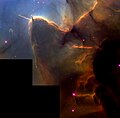Messier Index/M20
| Trifid Nebula | |
|---|---|
 | |
| Observation data: w:J2000 epoch | |
| Type | Emission/Reflection |
| Right ascension | 18h 02m 23s[1] |
| Declination | -23° 01′ 48″[1] |
| Distance | 2000 - 9000 ly |
| Apparent magnitude (V) | +6.3[1] |
| Apparent dimensions (V) | ~20 arcmins |
| Constellation | Sagittarius |
| Physical characteristics | |
| Radius | - |
| Absolute magnitude (V) | - |
| Notable features | - |
| Other designations | M20, NGC 6514[1], Sharpless 30, RCW 147, Gum 76 |
The Trifid Nebula (catalogued as Messier 20 or M20 and as NGC 6514) is an w:H II region located in Sagittarius. Its name means 'divided into three lobes'. The object is an unusual combination of an w:open cluster of w:stars, an w:emission nebula (the lower, red portion), a w:reflection nebula (the upper, blue portion) and a w:dark nebula (the apparent 'gaps' within the emission nebula that cause the trifid appearance; these are also designated Barnard 85). Viewed through a small w:telescope, the Trifid Nebula is a bright and colorful object, and is thus a perennial favorite of amateur astronomers.
Characteristics
The Trifid Nebula was the subject of an investigation by astronomers using the w:Hubble Space Telescope in w:1997, using filters that isolate emission from w:hydrogen w:atoms, w:ionized w:sulfur atoms, and doubly ionized w:oxygen atoms. The images were combined into a false-color composite picture to suggest how the nebula might look to the eye.
The close-up images show a dense cloud of dust and gas, which is a w:stellar nursery full of embryonic stars. This cloud is about 8 w:light years away from the nebula's central star. A w:stellar jet protrudes from the head of the cloud and is about 0.75 w:light-years long. The jet's source is a young stellar object deep within the cloud. Jets are the exhaust gasses of star formation. Radiation from the nebula's central star makes the jet glow.
The images also showed a finger-like stalk to the right of the jet. It points from the head of the dense cloud directly toward the star that powers the Trifid nebula. This stalk is a prominent example of an w:evaporating gaseous globules, or 'EGGs'. The stalk has survived because its tip is a knot of gas that is dense enough to resist being eaten away by the powerful radiation from the star.
In January, 2005, w:NASA's w:Spitzer Space Telescope discovered 30 embryonic stars and 120 newborn stars not seen in w:visible light images.
Gallery
-
M20 Amateur Image Courtesy Hunter Wilson
-
The Trifid Nebula in infrared as seen by the Spitzer Space Telescope
-
Credit:Adam Block-Mount Lemmon SkyCenter. University of Arizona (Board of Regents)
External links
- Spitzer IR Trifid discoveries
- Messier 20, SEDS Messier pages
- Trifid Nebula at ESA/Hubble
References
- ↑ a b c d "SIMBAD Astronomical Database". Results for NGC 6514. Retrieved 2006-11-16.





